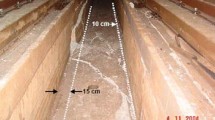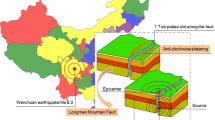Abstract
Many tunnels along the Dujiangyan to Wenchuan highway, located near the epicenter of the 2008 Wenchuan earthquake in China, were damaged severely. The characteristics of the tunnel failures were analyzed and categorized as avalanches and landsliding near the tunnels, cracking of the tunnel portals, collapse of the liner and surrounding rock, cracking and dislocation of the liner, uplift and cracking of the ground, deformation and cracking of the preliminary bracing. The main geological factors influencing the tunnel damage are secondary fractures of earthquake faults, sudden change in soil and rock type, weak rocks and the variable geo-stresses in the host material. The tunnel portals and their slopes, unless fully integrated into the tunnel structures and sufficiently reinforced, are likely to suffer significant distress as a consequence of seismic events. The main mitigation measures proposed are the use of reinforced concrete in the secondary lining in the area of fault zones and injection grouting to reduce the differences where there are sudden changes in the character of the host material.
Résumé
De nombreux tunnels le long de l’autoroute reliant Dujiangyan à Wenchuan, située près de l’épicentre du séisme de Wenchuan de 2008, ont été gravement endommagés. Les caractéristiques des ruptures de tunnels ont été analysées et classifiées ainsi que les avalanches de roches et les glissements près des tunnels, les fissurations des têtes de tunnels, les ruptures des revêtements et de la roche encaissante, les fissurations et dislocations du revêtement, les soulèvements et fissurations du terrain, les déformations et fissurations de confortements préliminaires. Les principaux facteurs géologiques responsables des dommages aux tunnels sont des fractures secondaires associées aux failles actives, des changements brutaux des types de sols ou de roches, des roches tendres et des variations d’états de contrainte dans le massif rocheux. Les têtes de tunnel et les pentes avoisinantes, à moins qu’elles ne soient complètement intégrées dans la structure du tunnel et suffisamment renforcées, sont susceptibles d’être fortement affectées par l’événement sismique. Les principales mesures d’atténuation de ces effets consistent en l’utilisation de béton armé dans le revêtement secondaire dans le secteur de zone faillée et l’injection de ciment pour réduire les différences là où se présentent des changements brutaux des caractéristiques du massif rocheux.
















Similar content being viewed by others
References
Chen YT (2008) Why was Wenchuan earthquake so serious? http://www.sciencenet.cn/htmlnews/2008/6/200862781145413208421.html (in Chinese)
Earthquake relief headquarter under the State Council of China (2008) Final report of Wenchuan great earthquake relief. (in Chinese)
Hashash YMA, Hook JJ, Schmidt B, Yao JI (2001) Seismic design and analysis of underground structures. Tunn Undergr Space Technol 16(4):247–293
Huang RQ, Li WL (2009) Analysis of the geo-hazards triggered by the 12 May 2008 Wenchuan earthquake, China. Bull Eng Geol Environ 68:363–371
Konagai K (2005) Data archives of seismic fault-induced damage. Soil Dyn Earthq Eng 25:559–570
Kontoe S, Zdravkovic L, Potts DM, Menkiti CO (2008) Case study on seismic tunnel response. Can Geotech J 45:1743–1764
Li TB (2008) Failure characteristics and influence factor analysis of mountain tunnels at epicenter zones of great Wenchuan earthquake. J Eng Geol 16(6):742–750 (in Chinese)
O’Rourke TD, Goh SH, Menkiti CO, Mair RJ (2001) Highway tunnel performance during the 1999 Duzce earthquake. In: Proceedings of the 15th international conference on soil mechanics and foundation engineering, vol 2. Balkema, Rotterdam, pp 1365–1368
Penzien J (2000) Seismically induced racking of tunnel linings. Int J Earthq Eng Struct Dyn 29(5):683–691
Sharma S, Judd WR (1991) Underground opening damage from earthquakes. Eng Geol 30:263–276
Towhata I (2008) Geotechnical earthquake engineering. Springer, Berlin
Wang WL, Wang TT, Su JJ, Lin CH, Seng CR, Huang TH (2001) Assessment of damage in mountain tunnels due to the Taiwan Chi-Chi earthquake. Tunn Undergr Space Technol 16:133–150
Wang ZZ, Gao B, Jiang YJ, Yuan S (2009) Investigation and assessment on mountain tunnels and geotechnical damage after the Wenchuan earthquake. Sci China Ser E-Tech Sci 52(2):546–558
Xu Q, Fan XM, Huang RQ, Westen CV (2009) Landslide dams triggered by the Wenchuan earthquake, Sichuan Province, south west China. Bull Eng Geol Environ 68:373–386
Yashiro K, Kojima Y (2007) Historical earthquake damage to tunnel in Japan and case studies of railway tunnels in the 2004 Niigataken-Chuetsu earthquake. Q Rep RTRI 48(3):136–141
Acknowledgments
This study is financially supported by Program for Changjiang Scholars and Innovative Research Team in University (IRT0812), Key Program for Research Group of SKLGP (SKLGP2009Z002), and Sichuan Province Science Funds for Young Scholars (09ZQ026-083). The author expresses his sincere thanks to Sichuan Highway Design Institute and Sichuan Jiaotong Design Institute for providing some data used in the paper, to Professor Huang Runqiu for his interest in the paper and to Professor Niek Rengers for his review of an earlier version of the manuscript. Thanks also to Junhui Shen, Hua Xu, Zhihong Gong, Yu Zhao, and Demin Xue for their help in the field investigation and data collection.
Author information
Authors and Affiliations
Corresponding author
Rights and permissions
About this article
Cite this article
Li, T. Damage to mountain tunnels related to the Wenchuan earthquake and some suggestions for aseismic tunnel construction. Bull Eng Geol Environ 71, 297–308 (2012). https://doi.org/10.1007/s10064-011-0367-6
Received:
Accepted:
Published:
Issue Date:
DOI: https://doi.org/10.1007/s10064-011-0367-6




